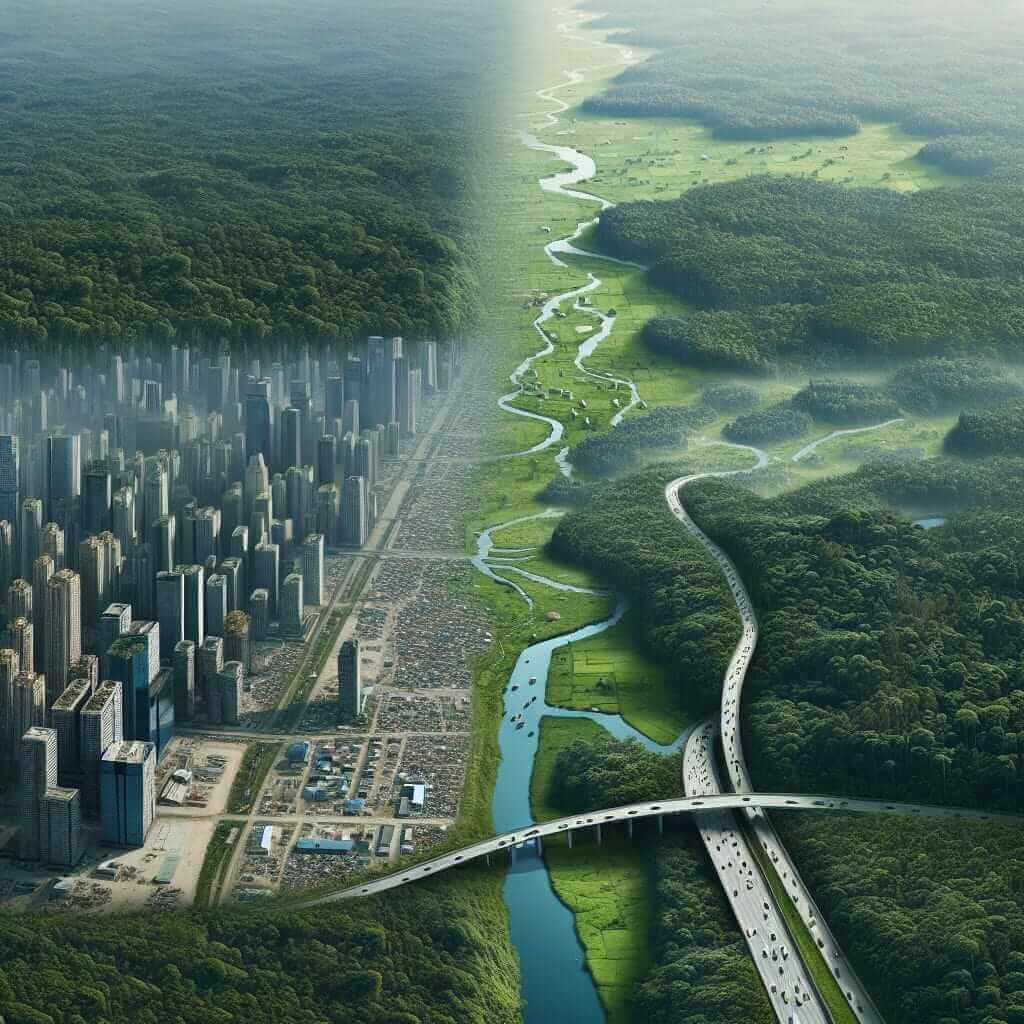The IELTS Reading test aims to assess your ability to understand and interpret information presented in written English. One of the common topics in recent IELTS Reading exams focuses on environmental issues, and “The effects of urban expansion on local ecosystems” is a significant subject within this context. With rapid urbanization, understanding its impact on local ecosystems has become increasingly relevant. Given the frequency and relevance of such topics, it’s imperative to prepare thoroughly.
Reading Practice Test: “The Effects of Urban Expansion on Local Ecosystems”
Reading Passage
Urban expansion, characterized by the growth of cities and metropolitan areas, has profound effects on local ecosystems. This expansion often leads to habitat destruction, loss of biodiversity, and disruption of natural processes. This passage discusses the multifaceted impacts of urban expansion on ecological systems.
Urban areas expand due to population growth and economic development, leading to an increased demand for housing, infrastructure, and services. This growth typically requires converting natural landscapes into urban environments, including buildings, roads, and other infrastructure, significantly impacting local ecosystems.

One of the primary effects of urban expansion is habitat destruction. Natural habitats such as forests, wetlands, and grasslands are converted into urban areas, resulting in the loss of flora and fauna specific to those regions. Species that cannot adapt to the new environment face extinction, leading to a decrease in biodiversity.
Urban expansion also disrupts natural processes such as water cycles and nutrient flows. For instance, the construction of roads and buildings alters water runoff patterns, often leading to increased pollution and sedimentation in nearby rivers and lakes. These changes can harm aquatic ecosystems and reduce water quality.
Additionally, urban areas contribute to the urban heat island effect, where cities experience higher temperatures than surrounding rural areas. This phenomenon is mainly due to the extensive use of concrete and asphalt, which absorb and retain heat. Elevated temperatures can affect local weather patterns and increase the energy consumption required for cooling.
Efforts to mitigate the adverse effects of urban expansion include implementing sustainable urban planning practices. Examples include creating green spaces, promoting public transportation, and using eco-friendly building materials. These practices can help reduce the environmental footprint of urban areas and preserve local ecosystems.
In summary, while urban expansion is necessary for accommodating growing populations, it poses significant challenges to local ecosystems. Addressing these challenges requires conscious planning and efforts to balance environmental impact with urban growth.
Questions
Multiple Choice
-
Which of the following is NOT mentioned as a consequence of urban expansion?
a. Loss of biodiversity
b. Decrease in water quality
c. Economic decline
d. Urban heat island effect -
What is one of the primary causes of urban expansion?
a. Technological advancements
b. Population growth
c. Climate change
d. Agricultural development
True/False/Not Given
-
Species that can adapt to new urban environments face extinction.
- True
- False
- Not Given
-
Urban expansion has no impact on the water cycles and nutrient flows.
- True
- False
- Not Given
Matching Headings
- Match the following sentences to the correct paragraph:
a. This paragraph discusses ways to balance urban growth with environmental impact.
b. This paragraph describes the changes in natural water runoff patterns caused by urban expansion.
c. This paragraph explains the primary causes of urban expansion.
d. This paragraph explores the phenomenon where urban areas are warmer than their rural surroundings.
Summary Completion
- Fill in the blanks with NO MORE THAN THREE WORDS.
Urban expansion typically requires converting __ into urban environments. This often leads to habitat destruction and loss of __. Efforts to mitigate these effects include creating __ and using eco-friendly building materials.
Answer Key
- c. Economic decline – Urban expansion leads to economic growth, not decline.
- b. Population growth – Urban expansion often occurs to accommodate increasing populations.
- False – Only species that cannot adapt face extinction.
- False – Urban expansion significantly impacts water cycles and nutrient flows.
-
- a (Paragraph 6)
- b (Paragraph 4)
- c (Paragraph 2)
- d (Paragraph 5)
- Natural landscapes, biodiversity, green spaces
Common Mistakes
- Confusing details: Many test-takers confuse specifics such as “urban heat island effect” with broader concepts like “climate change.”
- Not reading properly: Failing to read questions carefully may lead to misunderstandings, particularly in True/False/Not Given sections.
- Vocabulary misunderstanding: Misinterpreting terms like “biodiversity” and “sustainable urban planning” can lead to incorrect answers.
Vocabulary
- Habitat Destruction (noun): ˈhæbɪtæt dɪˈstrʌkʃən – The process in which natural habitat is rendered unable to support the species present.
- Biodiversity (noun): ˌbaɪoʊdaɪˈvɜːrəsɪti – The variety of plant and animal life in a particular habitat.
- Urban Heat Island Effect (phrase): ˈɜːrbən hiːt ˈaɪlənd ɪˈfɛkt – The phenomenon where urban areas are significantly warmer than their rural surroundings.
Grammar Focus
- Relative Clauses: Used to provide additional information about a noun without starting a new sentence. For example, “Species that cannot adapt to the new environment face extinction.”
- Passive Voice: Often used to emphasize the action rather than the subject performing the action. For example, “Natural habitats are converted into urban areas.”
Recommendations for High IELTS Reading Scores
- Practice: Consistently practice with high-quality materials that mirror the actual test.
- Analyze Mistakes: Review your errors to understand where you went wrong.
- Expand Vocabulary: Pay special attention to words commonly found in IELTS Reading passages.
- Time Management: Practice under timed conditions to improve your pacing.
Remember, achieving a high score in the IELTS Reading section takes consistent practice and a deep understanding of various topics, including the effects of urban expansion on local ecosystems. Keep practicing, stay focused, and you will succeed.